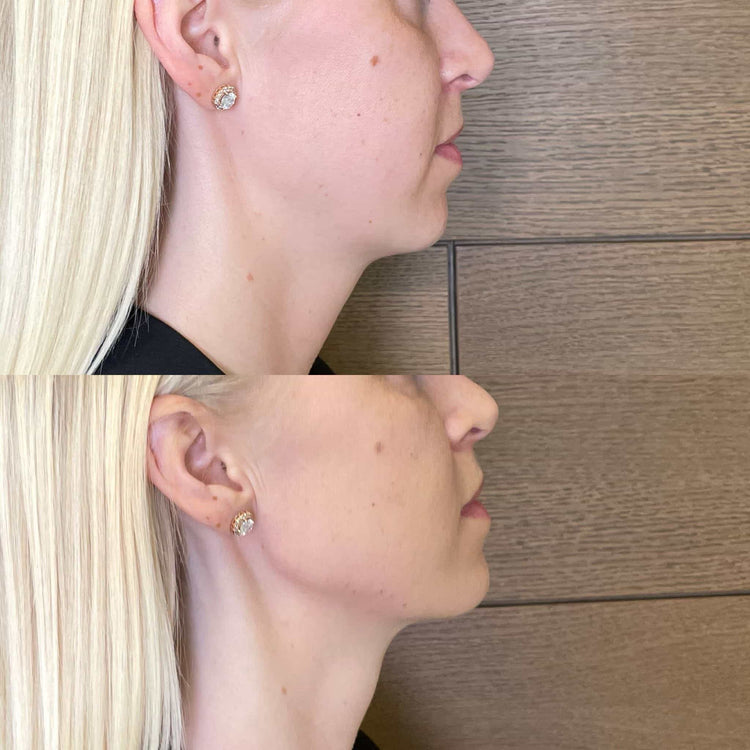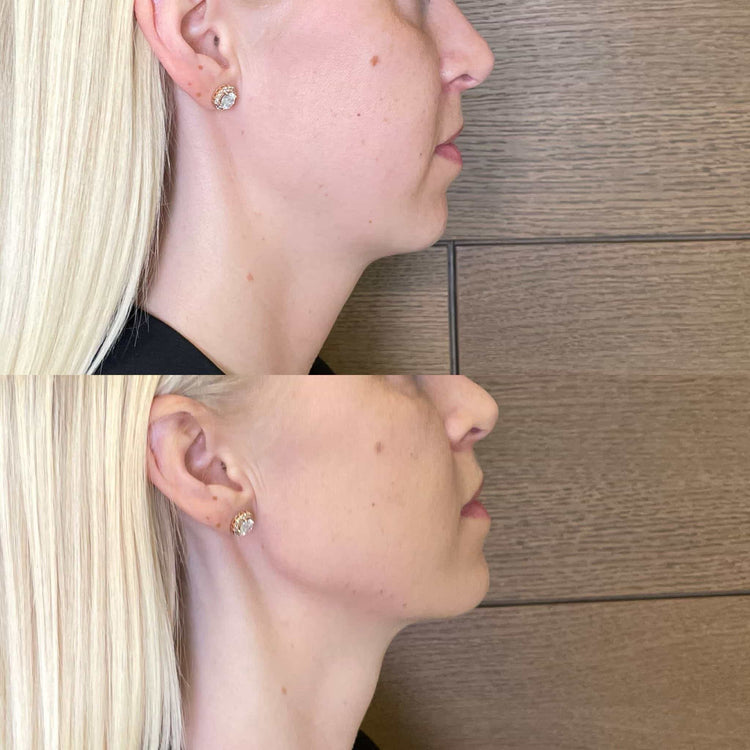Safety of Jaw Fillers in the UK
In recent years, jaw fillers have gained significant popularity as a non-surgical way to contour and define the jawline. But with any cosmetic procedure, safety is paramount. Understanding the potential risks and benefits associated with jaw fillers in the UK is essential for anyone considering this treatment.
Regulatory Framework for Cosmetic Procedures
Jaw fillers are administered by injecting a hyaluronic acid gel into the jaw area, adding volume and creating a more defined jawline. The UK has a regulatory framework in place to ensure the safety of cosmetic procedures, including jaw filler treatments. The Medicines and Healthcare products Regulatory Agency (MHRA) regulates all medical devices and substances used in cosmetic procedures.

To be legally administered, jaw fillers must be approved by the MHRA and only qualified healthcare professionals registered with the General Medical Council (GMC) or General Dental Council (GDC) can perform these treatments.
As with any medical procedure, there are potential risks associated with jaw fillers. These may include swelling, bruising, infection, allergic reactions, and in rare cases, migration of the filler material.
It’s crucial to choose a reputable clinic and practitioner with extensive experience in administering jaw fillers. Thoroughly discuss your expectations, concerns, and medical history with your practitioner before undergoing any treatment.
Qualifications and Experience of Practitioners
When considering jaw fillers in the UK, safety is paramount. The Medicines and Healthcare products Regulatory Agency (MHRA) ensures all used materials are approved, and treatments must be performed by qualified healthcare professionals registered with the General Medical Council (GMC) or General Dental Council (GDC).
Potential risks include swelling, bruising, infection, allergic reactions, and rare occurrences of filler migration. To minimize these risks, choose a reputable clinic and practitioner with extensive experience in jaw fillers. Open communication with your practitioner about your expectations, concerns, and medical history is crucial before undergoing treatment.
Approved Filler Products and Their Safety Profiles
Jaw fillers have become increasingly popular for contouring the jawline, offering a non-surgical alternative to achieve a more defined look. The UK has established regulations to ensure the safety of such cosmetic procedures.
To be legally administered in the UK, jaw fillers must receive approval from the Medicines and Healthcare products Regulatory Agency (MHRA). Only qualified healthcare professionals registered with either the General Medical Council (GMC) or the General Dental Council (GDC) are authorized to perform these treatments.
- Swelling
- Bruising
- Infection
- Allergic Reactions
- Rare occurrences of filler migration
It is essential to choose a reputable clinic and practitioner with significant experience in administering jaw fillers. Before undergoing treatment, have a thorough discussion with your practitioner about your expectations, any concerns you may have, and your medical history.
Potential Risks and Complications
While jaw fillers offer a non-surgical path to a more defined jawline, it’s crucial to be aware of the potential risks involved. Complications can include swelling, bruising, infection, allergic reactions, and in rare instances, filler migration.
Temporary Side Effects
Potential complications associated with jaw fillers include swelling, bruising, infection, allergic reactions, and in rare cases, migration of the filler material.
Temporary side effects are also common and usually subside within a few days to weeks. These can include redness, tenderness, itching, and temporary numbness around the injection site.
Allergic Reactions
Potential risks and complications associated with jaw fillers in the UK include swelling, bruising, infection, allergic reactions, and in rare cases, migration of the filler material.
- Swelling
- Bruising
- Infection
- Allergic Reactions
- Filler Migration
Infection Risk
Potential complications associated with jaw fillers can include swelling, bruising, infection, allergic reactions, and in rare cases, migration of the filler material.
Infection risk is a concern with any procedure involving injections. Maintaining strict sterilization protocols and using properly sterilized needles are crucial to minimize this risk.
Choosing a qualified practitioner who adheres to best practices for hygiene and safety is essential for reducing the risk of infection.
Nerve Damage
Potential complications associated with jaw fillers can include swelling, bruising, infection, allergic reactions, and in rare cases, migration of the filler material.
- Swelling
- Bruising
- Infection
- Allergic Reactions
- Filler Migration
Choosing a Reputable Clinic and Practitioner
When considering jaw fillers to enhance your jawline, selecting a reputable clinic and practitioner is paramount. Thorough research and careful consideration are essential to ensure a safe and successful outcome.
Researching Clinics and Practitioners
Choosing a reputable clinic and practitioner is crucial for any cosmetic procedure, and jaw fillers are no exception. Begin by researching clinics in your area that specialize in facial aesthetics. Look for clinics with experienced practitioners who are certified and registered with relevant professional bodies.
Read online reviews from previous patients to get an idea of their experiences and the clinic’s reputation. Pay attention to feedback regarding the practitioner’s skill, communication style, and patient care.
Don’t hesitate to contact clinics directly to ask questions about their experience with jaw fillers, their approach to treatment, and any potential risks involved. A reputable clinic will be transparent and willing to provide you with all the information you need to make an informed decision.
Additionally, check if the clinic uses high-quality, FDA-approved fillers and adheres to strict hygiene and safety protocols.
Consultation Process and Expectations
Choosing a reputable clinic and practitioner is paramount when considering jaw fillers. Thorough research and careful consideration are essential to ensure a safe and successful outcome. Begin by researching clinics in your area that specialize in facial aesthetics.

Look for clinics with experienced practitioners who are certified and registered with relevant professional bodies. Read online reviews from previous patients to gauge their experiences and the clinic’s reputation.
Pay attention to feedback regarding the practitioner’s skill, communication style, and patient care. Don’t hesitate to contact clinics directly to ask questions about their experience with jaw fillers, their approach to treatment, and any potential risks involved.
A reputable clinic will be transparent and willing to provide you with all the information you need to make an informed decision. Ensure the clinic uses high-quality, FDA-approved fillers and adheres to strict hygiene and safety protocols.
The consultation process is crucial for understanding the procedure, potential risks, and realistic outcomes. During your consultation, discuss your desired aesthetic goals with the practitioner and inquire about their experience with jaw filler treatments.
It’s important to ask about the type of filler they use, the injection technique they employ, and any potential side effects or complications.
Review before-and-after photos of previous patients to get a sense of their results and whether the practitioner’s style aligns with your aesthetic preferences.
Understand that jaw fillers are not permanent, and touch-up appointments may be necessary to maintain the desired results. Discuss the expected duration of the filler and the frequency of follow-up treatments during your consultation.
Before undergoing any treatment, ensure you understand the costs involved, including the initial procedure, potential touch-up appointments, and any additional expenses such as anesthesia or aftercare products.
Patient Reviews and Testimonials
Choosing a reputable clinic and practitioner is paramount when considering jaw fillers. Thorough research and careful consideration are essential to ensure a safe and successful outcome. Begin by researching clinics in your area that specialize in facial aesthetics.
Look for clinics with experienced practitioners who are certified and registered with relevant professional bodies. Read online reviews from previous patients to gauge their experiences and the clinic’s reputation.
Pay attention to feedback regarding the practitioner’s skill, communication style, and patient care. Don’t hesitate to contact clinics directly to ask questions about their experience with jaw fillers, their approach to treatment, and any potential risks involved.
A reputable clinic will be transparent and willing to provide you with all the information you need to make an informed decision. Ensure the clinic uses high-quality, FDA-approved fillers and adheres to strict hygiene and safety protocols.
The consultation process is crucial for understanding the procedure, potential risks, and realistic outcomes. During your consultation, discuss your desired aesthetic goals with the practitioner and inquire about their experience with jaw filler treatments.
It’s important to ask about the type of filler they use, the injection technique they employ, and any potential side effects or complications. Review before-and-after photos of previous patients to get a sense of their results and whether the practitioner’s style aligns with your aesthetic preferences.
Understand that jaw fillers are not permanent, and touch-up appointments may be necessary to maintain the desired results. Discuss the expected duration of the filler and the frequency of follow-up treatments during your consultation.
Before undergoing any treatment, ensure you understand the costs involved, including the initial procedure, potential touch-up appointments, and any additional expenses such as anesthesia or aftercare products.
Aftercare and Long-Term Considerations
While jaw fillers offer a non-surgical approach to contouring the jawline, it’s crucial to consider the long-term implications. The effects of jaw fillers are not permanent and typically last between 6 to 18 months.
Touch-up appointments will likely be needed to maintain the desired results. Discuss the longevity of the filler and the frequency of touch-ups with your practitioner during your consultation.
It’s also important to understand that jaw fillers, like any cosmetic procedure, carry potential risks and side effects, some of which may require long-term management.
These can include migration of the filler material, lumps or bumps, and changes in skin texture. Regular follow-up appointments with your practitioner are essential to monitor for any complications and ensure optimal results.
Post-Treatment Instructions and Recovery
Aftercare instructions are crucial for optimizing the outcome of jaw filler treatments and minimizing potential risks. Your practitioner will provide specific guidelines tailored to your individual needs, but some common recommendations include:
- Avoid touching or massaging the treated area for several days to prevent inflammation and ensure proper settling of the filler.
- Apply ice packs to the area intermittently to reduce swelling and bruising.
- Keep your head elevated while sleeping to minimize fluid accumulation.
- Avoid strenuous activity or exercise for a few days after treatment.
- Refrain from using topical skincare products on the treated area until your practitioner gives clearance.
- Stay hydrated by drinking plenty of water.
- Protect your skin from excessive sun exposure and use sunscreen regularly.
It’s important to follow your practitioner’s instructions carefully and attend all scheduled follow-up appointments. Promptly report any unusual symptoms or concerns to your practitioner.

Maintenance Fillers and Repeat Treatments
Aftercare is vital for optimizing jaw filler results and minimizing risks. Your practitioner will provide specific instructions, but common recommendations include avoiding touching or massaging the treated area, applying ice packs to reduce swelling, elevating your head while sleeping, and refraining from strenuous activity.
Avoid using topical skincare products on the treated area until cleared by your practitioner. Stay hydrated, protect your skin from sun exposure, and attend all follow-up appointments.
Jaw filler results are not permanent and typically last between 6 to 18 months. Touch-up appointments will likely be needed to maintain the desired appearance.
Discuss the longevity of the filler and the frequency of touch-ups with your practitioner during your consultation.
Maintenance fillers involve repeat treatments to sustain the results achieved with initial jaw filler injections.
The frequency of these repeat treatments varies depending on factors such as the type of filler used, individual metabolism, and lifestyle.
Your practitioner will advise you on the appropriate timing for follow-up appointments based on your specific needs and goals.
Long-Term Risks and Potential for Complications
Aftercare is crucial for optimizing jaw filler results and minimizing potential risks. This typically involves avoiding touching or massaging the treated area, applying ice packs to reduce swelling, elevating your head while sleeping, and refraining from strenuous activity. Your practitioner will provide detailed instructions on how to care for your treated areas post-procedure.
Long-term considerations include understanding that jaw filler effects are not permanent and typically last between 6 to 18 months. You should expect to have touch-up appointments to maintain the desired results. Regular follow-up appointments with your practitioner are also important to monitor for any complications or changes in your treated areas.
Potential long-term risks associated with jaw fillers can include filler migration, lumps or bumps, and changes in skin texture. These issues require careful management and may necessitate further treatment. It’s essential to communicate openly with your practitioner about any concerns you have regarding the long-term effects of your jaw filler procedure.
- Alluzience Longer Lasting Botox Near Dormansland, Surrey - May 1, 2025
- Can Chin Fillers Get Rid Of A Bum Chin? - April 30, 2025
- How Do You Fix Nasal Flaring? - April 30, 2025
